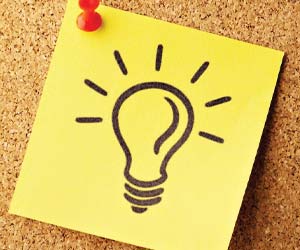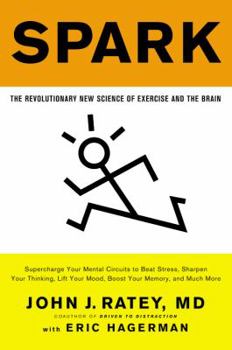Spark: The Revolutionary New Science of Exercise and the Brain
Select Format
Select Condition 
Book Overview
A groundbreaking and fascinating investigation into the transformative effects of exercise on the brain, from the bestselling author and renowned psychiatrist John J. Ratey, MD. Did you know you can beat stress, lift your mood, fight memory loss, sharpen your intellect, and function better than ever simply by elevating your heart rate and breaking a sweat? The evidence is incontrovertible: Aerobic exercise physically remodels our brains...
Format:Paperback
Language:English
ISBN:0316113514
ISBN13:9780316113519
Release Date:January 2013
Publisher:Little, Brown Spark
Length:304 Pages
Weight:0.64 lbs.
Dimensions:0.9" x 5.4" x 8.2"
Customer Reviews
5 ratings
This book could change your life
Published by Thriftbooks.com User , 16 years ago
John Ratey is well known for his groundbreaking work on Attention Deficit Disorder. He coauthored the book, "Driven to Distraction" with Ed Hallowell. His newest book is "Spark- The Revolutionary New Science of Exercise and the Brain." I found Spark a fascinating read. Ratey cites dozens of studies that span decades and continents. All point to the same conclusion: exercise, and aerobic exercise in particular, boosts the release of important neurotransmitters and enhances cognitive function. For people with ADD or ADHD, this boost can be life changing. Ratey is not prescribing exercise as the "cure" for attention issues, but he does offer specific examples of people who have used exercise to combat the negative effects of stress and attention problems. Many were able to reduce or eliminate ADD medications, though he clearly states that for some people, a combination treatment of both medication and structured exercise may be best. Ratey talks at length about the success of a special gym program instituted in Naperville, Illinois. The emphasis is on personal fitness. Students in this area have very strong tests scores and a very low rate of childhood obesity. In other places around the country that have implemented a similar program, standardized scores have risen dramatically. These case studies are fascinating. "Spark" has inspired me to increase my own exercise routine, and also to institute morning recess at home each day. My homeschooled kids are absolutely loving it and we're finding the morning transitions go much more smoothly when we all look forward to getting outside and moving our bodies! We've been running laps on the driveway (five times back and forth to the mailbox is about a mile), doing calisthenics, playing four square, jump rope, and kickball. My three year old has her own method of jumping jacks that is just hilarious to watch. My daughter who has the hyperactive sort of attention deficit enjoys sprinting before school, and appears to have less trouble focusing after she has been active. I think my next investment will be a basketball hoop! Everyone knows that exercise is good for the body, but it is high time that we recognize how good it is for the mind. For a child who has attention issues, a solid workout each morning may make a real difference. I'd be skeptical of a drug that claimed to, "supercharge your mental circuits to beat stress, sharpen your thinking, lift your mood, boost your memory, and much more" , but these are very real affects that regular exercise can produce. Not all exercise is equally effective in fighting symptoms of ADD. Read this book to find out how to implement a regimen that will work for you or your children.
Regular Aerobic Exercise Helps School Performance and Improves Mental Performance During Stress, Anx
Published by Thriftbooks.com User , 16 years ago
I've read a lot about the brain in the last decade, and I thought this book was the most helpful summary I've seen of what to do differently. The thinking person is the person who aerobically exercises regularly. Spark is an excellent summary of the brain research during the last decade or so that has added to our knowledge of how regular aerobic exercise stimulates better and more effective mental activity. Dr. Ratey considers the impact of such exercise on school-age children . . . and adults with stress, anxiety, depression, attention deficits, hormonal changes, and aging bodies. He also recommends a general exercise regime that seems to optimize what we know today from these studies. The essence of the book can be found in the observation that optimal brain functioning requires plenty of blood, the right nutrients, a balance of body chemicals designed to help the brain operate, and an ability to grow new cells and connections in the brain. Each of these elements is helped by regular aerobic exercise. The results are often measurable within a few weeks. So if you thought that aerobic exercise was simply about looking and feeling good, you're wrong. It's also about thinking well and being able to learn. There are longevity and other quality of life benefits as well . . . including reduced incidence of disease and less chance of dementia. The book also explores that you don't have to do a tremendous amount of exercise to get most of the benefits.
Eye Opening
Published by Thriftbooks.com User , 16 years ago
Our doctors always say to get more exercise. We always yawn and say of course; we've heard it all before. And then we are mediocre in our follow up. After reading Spark my entire viewpoint has changed. Exercise is a master key to brain functioning. Cholesterol and other system problems caused by lack of exercise are a bit ambiguous since we often can't directly feel them until we manifest some disease. Brain functioning is something else entirely. We can feel an almost immediate change after aerobic exercise. After reading Spark I definitely have become a six day a week exerciser. I need my brain functioning as well as possible, and the data in this book has made a believer out out of me.
The brain-exercise connection finally explained !!
Published by Thriftbooks.com User , 16 years ago
Having ready 2 previous books by John : The users guide to brain and Driven by distraction i was looking forward to reading SPARK. I was especially interested in learning how John was going to tie exercise with the brain functioning since i am a strong supporter of exercise and have experienced its benefits. I knew before reading SPARK that exercise in some way does make you feel better. But SPARK puts it in perspective from a scientific point of view. The chapters on Stress and depression particularly caught my attention since most of us struggle with these 2 issues at some point in life and again most of us turn to popping a pill to deal with it. If its as simple as getting on a treadmill or a bike and working out for 30-45 minutes without any side effects, then it seems only logical to do it. The BDNF (Miracle-gro as John calls it) was a very interesting read for me. I did had to go back and re-read certain topics as was it too much medical terms to comprehend in one read. But once i got it, it became permanent and that's the beauty of this book. Its simple yet powerful in its message. The simplicity comes from the fact that "you goto workout ". The power comes from the facts / data that proves "why you goto workout". Once the reader ties the two together, the message is very clear and hopefully will remain for a lifetime with the reader. Today if you look around there is a lot of awareness among people about the ill-effects of obesity. There are TV programs, advertisements, books about why exercising is good for you and how it will help you be more fit. But this is the only books that tells you that exercise will also make your brain fit along with your body. The brain-body connection is important and one cannot be ignored over the other.
The Brain on Exercise
Published by Thriftbooks.com User , 16 years ago
This book explains in clear terms the role exercise plays in our mental processes. Moving our muscles produces proteins that play roles in our highest thought processes. Ratey says, "thinking is the internalization of movement." He illustrates this with the story of the sea squirt that hatches with a rudimentary spinal cord and 300 brain cells. It has only hours to find a spot of coral on which to put down roots or die. When it does put down roots, it eats its brain. According to Ratey only a moving animal needs a brain. He begins with the value exercise has for the learning process in high school students: improved academic performance, alertness, attention and motivation. He cites studies that say we can alter our mental states by physically moving. He said depression is the leading cause of disability in the U.S. He then presents a chapter where depression is relieved in case studies by exercise. Among the areas Ratey covers are: stress, depression, ADD, and aging. This book is a great motivator for exercise. However, Ratey's work was preceded by Glenn Doman's. Doman advocated exercise for brain injured children in the 1950s when the only 'treatment' was to institutionalize them. He later started a `super babies' program. Both the educational and medical establishments attacked and marginalized Doman's work.
Spark: The Revolutionary New Science of Exercise and the Brain Mentions in Our Blog

Second Semester Reset for Students
Published by Ashly Moore Sheldon • January 12, 2023
High school and college students may be feeling weary as they head back into classes during these winter months. Here are some books and guides to help them get organized, focused, and energized.






